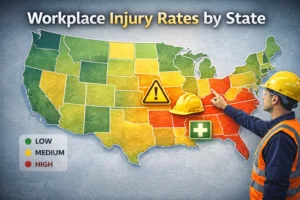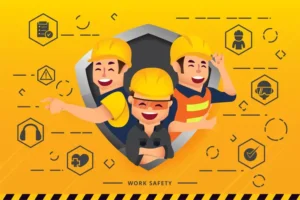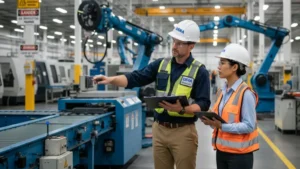How to Clean up Jobsites Effectively
A clean jobsite is more than just about appearances; it’s a vital factor in maintaining safety, efficiency, and compliance. Clutter, debris, and poor organization are among the leading causes of workplace accidents, including slips, trips, and falls. OSHA emphasizes housekeeping as a core element of jobsite safety, making it a responsibility every employer and worker must prioritize. By implementing structured cleaning practices, teams can reduce hazards, improve workflow, and extend the lifespan of tools and equipment. Good housekeeping practices in the workplace not only create a safer environment but also boost worker morale and productivity, ensuring projects stay on track.
9 Effective Workplace Housekeeping Checklist
Keeping jobsites safe and efficient requires more than basic tidying-it calls for consistent, structured cleanup methods. These nine proven practices help reduce hazards while keeping work areas organized and compliant.
Start with a Pre-Cleanup Walkthrough
Before beginning the cleanup, conduct a walkthrough to assess the site’s condition. Look for hazards such as loose debris, chemical spills, or sharp objects that could pose risks. Identify high-traffic areas that require immediate attention and note where waste has accumulated. This proactive step ensures workers clean strategically, focusing on both safety and efficiency.
Use a Standardized Checklist
A structured cleanup checklist helps maintain consistency across teams and shifts. Daily, weekly, and end-of-shift tasks can be outlined to cover everything from removing debris to sanitizing equipment. This approach minimizes overlooked areas and creates accountability, ensuring the jobsite remains organized and hazard-free.
Prioritize Walkways and High-Traffic Zones
Keeping pathways, stairways, and exits clear is essential for safety and productivity. Cluttered walkways increase the risk of slips, trips, and falls, which are among the most common jobsite accidents. Regularly checking and cleaning these areas ensures workers can move efficiently without unnecessary risks.
Segregate and Label Waste Properly
Proper waste segregation reduces safety hazards and simplifies disposal. Hazardous and non-hazardous waste should always be separated, with clear labels and color-coded bins for recyclables. This practice not only keeps the site orderly but also ensures compliance with environmental and safety regulations.
Maintain Organized Tool and Material Storage
An organized storage system helps minimize accidents and saves time on the jobsite. Tools should be returned to their designated places after use, heavy materials must be securely stacked, and storage areas should be clearly labeled. This reduces clutter, prevents damage, and enhances overall workflow efficiency.
Control Dust and Airborne Debris
Dust and airborne particles not only create a mess but also pose respiratory hazards and reduce visibility on jobsites. Regular sweeping, vacuuming with HEPA filters, and wet suppression methods help control dust buildup. Ventilating enclosed spaces ensures clean air circulation and reduces health risks for workers.
Address Spills Immediately
Oil, grease, and chemical spills can quickly lead to slips, fire hazards, or chemical exposure. Using appropriate spill kits and absorbents is essential for safe cleanup. Workers should also post warning signs until the area is safe, preventing accidents and maintaining compliance with OSHA standards.
Incorporate End-of-Day Cleanup Routines
Establishing structured cleanup routines at the end of each shift ensures that clutter and waste don’t accumulate. Assigning responsibilities to teams helps distribute tasks like sweeping, tool checks, and waste removal. This habit fosters a safe, organized, and ready-to-use jobsite each morning.
Promote Accountability Among Workers
Cleanliness and safety are team responsibilities, not just management’s duty. Training workers on housekeeping practices and making tidiness part of the safety culture reinforces accountability. When workers take ownership of cleanup, jobsites remain safer, more efficient, and more professional in appearance.
The Importance of Jobsite Cleaning Training for Worker Safety
Jobsite cleaning training ensures workers understand not just what to clean but how to do it safely and effectively. A structured training program improves efficiency, reduces accidents, and strengthens compliance with OSHA housekeeping standards. By making cleaning a part of safety culture, employers can maintain cleaner, more productive worksites.
- 📌 Educates workers on proper waste segregation and disposal.
- 📌 Reduces slip, trip, and fall hazards through safe cleanup practices.
- 📌 Builds awareness of handling hazardous materials safely.
- 📌 Encourages accountability and shared responsibility among teams.
- 📌 Helps companies stay aligned with OSHA housekeeping requirements.
Common Mistakes to Avoid in Jobsite Cleaning
Even with safety programs in place, many jobsites still fall into patterns that undermine cleaning efforts and create hidden risks. These mistakes not only impact productivity but can also lead to accidents, OSHA violations, and costly project delays. Below are some of the most common pitfalls and why they matter.
Rushing Through Cleanup Tasks
Workers may feel pressured to leave quickly at the end of the shift, leading to hasty cleaning. This often results in overlooked debris such as nails, scrap materials, and loose cords, which become tripping hazards. Taking shortcuts during cleanup can undo a day’s worth of safe practices in just a few minutes.
Improper Waste Disposal
Mixing hazardous waste (like chemicals, sharp objects, or contaminated rags) with general construction debris is a serious mistake. Not only does this increase the risk of exposure to toxic substances, but it also violates OSHA and environmental regulations. Properly segregating, labeling, and disposing of waste keeps the site compliant and safer for everyone.
Neglecting High-Risk Zones
Areas such as scaffolding platforms, stairwells, and narrow corridors are often skipped during general cleaning because they are harder to access. These spaces, however, are among the most dangerous. A single overlooked spill or piece of clutter in these areas can lead to severe accidents.
Failure to Restock Cleaning Supplies
Running out of essentials like waste bins, spill kits, or absorbent materials is a frequent oversight. Without the right tools, workers either improvise or ignore messes altogether. A well-stocked supply system ensures that cleanup tasks are carried out properly and without delay.
Lack of Accountability
When cleaning duties are not clearly assigned, workers may assume someone else will take care of them. This results in inconsistent standards and unfinished tasks. Establishing a clear chain of responsibility and rotating cleanup roles fosters accountability and ensures every shift ends with a safe, orderly site.
Wrap Up
A clean jobsite directly supports safety, efficiency, and worker health. By avoiding mistakes like neglecting walkways or mishandling waste, and by providing proper jobsite cleaning training, companies can reduce risks and boost productivity. Consistent housekeeping builds accountability, prevents accidents, and keeps projects running smoothly.




